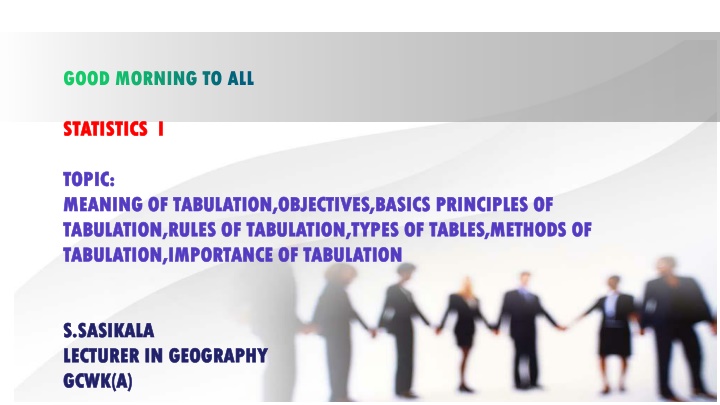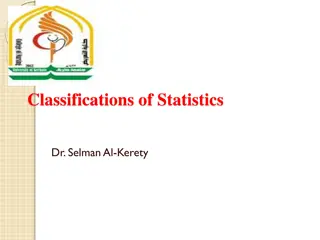STATISTICS I STATISTICS I
Tabulation in statistics refers to the systematic presentation of numerical data in rows and columns to simplify complex information, bring out essential features, facilitate comparison, enable statistical analysis, and save space. It serves as a crucial tool for organizing and analyzing data efficiently.
Download Presentation

Please find below an Image/Link to download the presentation.
The content on the website is provided AS IS for your information and personal use only. It may not be sold, licensed, or shared on other websites without obtaining consent from the author.If you encounter any issues during the download, it is possible that the publisher has removed the file from their server.
You are allowed to download the files provided on this website for personal or commercial use, subject to the condition that they are used lawfully. All files are the property of their respective owners.
The content on the website is provided AS IS for your information and personal use only. It may not be sold, licensed, or shared on other websites without obtaining consent from the author.
E N D
Presentation Transcript
GOOD MORNING TO ALL GOOD MORNING TO ALL STATISTICS I STATISTICS I TOPIC: TOPIC: MEANING OF TABULATION,OBJECTIVES,BASICS PRINCIPLES OF MEANING OF TABULATION,OBJECTIVES,BASICS PRINCIPLES OF TABULATION,RULES OF TABULATION,TYPES OF TABLES,METHODS OF TABULATION,RULES OF TABULATION,TYPES OF TABLES,METHODS OF TABULATION,IMPORTANCE OF TABULATION TABULATION,IMPORTANCE OF TABULATION S.SASIKALA S.SASIKALA LECTURER IN GEOGRAPHY LECTURER IN GEOGRAPHY GCWK(A) GCWK(A)
Tabulation Meaning: Tabulation is a systematic & logical presentation of numeric data in rows and columns, to facilitate comparison and statistical analysis. It facilitates comparison by bringing related information close to each other and helps in further statistical analysis and interpretation. Tabulation Meaning: To put it in other words, the method of placing organised data into a tabular form is called as tabulation. It may be complex, double or simple depending upon the nature of categorisation.
5 Major Objectives Of Tabulation: (1) To Simplify the Complex Data 5 Major Objectives Of Tabulation: (1) To Simplify the Complex Data It reduces the bulk of information i.e. raw data in a simplified and meaningful form so that it could be easily by a common man in less time. (2) To Bring Out Essential Features of the Data (2) To Bring Out Essential Features of the Data It brings out the chief/main characteristics of data. It presents facts clearly and precisely without textual explanation. (3) To Facilitate Comparison (3) To Facilitate Comparison Presentation of data in row & column is helpful in simultaneous detailed comparison on the basis of several parameters.
4) To Facilitate Statistical Analysis 4) To Facilitate Statistical Analysis Tables serve as the best source of organised data for further statistical analysis. The task of computing average, dispersion, correlation, etc. becomes much easier if data is presented in the form of a table. (5) Saving of Space (5) Saving of Space A table presents facts in a better way than the textual form. It saves space without sacrificing the quality and quantity of data.
STUDENTS LIST FOR ANALY SIS ABOUT THEM AGE SL.NO 1 2 3 4 5 6 7 NAME NITHYA KEERTHANA LALITHA MADAVI VIGNESWARI ABINAYA SESHMA D.O.B 20. D.O.J
Essential parts of a table: A statistical table is divided into 8 parts, which are explain below. Essential parts of a table: i. Title of the table: i. Title of the table: A title is a heading at the top of the table describing its contents. A title usually tells us, what is the nature of the data, where the data are, what time period do the data cover, how are the data classified. ii. Caption: ii. Caption: The headings for various column and rows are called columns caption and row caption.
iii. Box head: iii. Box head: The portion of the table containing Column caption is called box head. iv. Stub: iv. Stub: The portion of the table containing row caption is called stub.
v. Body of the table: The body of the table contains the statistical data which have to be presented in different rows and column. v. Body of the table: vi. Prefatory notes or head notes: Prefatory note appears between title and body of the table and enclosed in brackets. It is used to throw some light about the units of measurements e.g. in lakhs, in thousand, in tones etc. vi. Prefatory notes or head notes:
vii. Foot note: A foot note an always given at the bottom of the table but above the source note. Afoot note is a statement about something which is not clear from headings, title, stubs and captions etc. suppose when the profit earned by a company is shown in a table footnote should define whether it is profit before tax or profit after tax. vii. Foot note: A source note is placed immediately below the table but after the footnote. It refers to the source from where information has been taken. viii. Source note: viii. Source note:
THANKS TO ALL THANKS TO ALL























